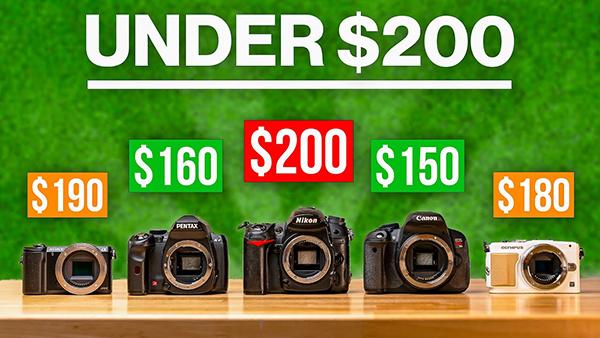You can photograph projects without expensive cameras, even if you’re a non-profit or photographer with a small budget. As leading manufacturers continue to raise prices on their entry-level models and gradually reduce their budget offerings, many might feel tempted to explore the plethora of inexpensive cameras available through various online marketplaces. However, I strongly advocate for a more sensible approach – exploring the second-hand market, where exceptional value awaits the discerning buyer.
Whilst I shall refrain from singling out specific brands, a quick browse through Amazon’s digital camera section reveals an abundance of suspiciously cheap devices, ranging from £15 to several hundred pounds. Though these bargain-basement prices might seem enticing, they often mask fundamental quality issues. These cameras typically deliver subpar results that pale in comparison to the imaging capabilities of modern smartphones, despite their grandiose marketing claims.
I acknowledge there are select scenarios where these basic cameras might serve a purpose – perhaps as a starter device for a young child who might accidentally damage or misplace their first camera. Even then, with a marginally higher budget, one could secure a pre-owned rugged camera built to withstand considerable wear and tear.
I’m also mindful that some photographers face genuine financial constraints that limit their ability to fully leverage the used camera market, particularly when working with a strict budget of around £100. While finding a vintage DSLR and basic lens combination within this price range can be challenging, it’s not entirely impossible.
Consider this: one could acquire a Canon EOS 20D with its standard 18-55mm kit lens from reputable dealers like KEH for approximately £65. Adding a CompactFlash card and reader would bring the total investment to roughly £100. Despite its age and modest 8.2-megapixel sensor, this setup remains capable of producing impressive photographs. After all, professional photographers created remarkable images with far less sophisticated equipment for many years.
However, in today’s market, a reasonable budget for a “new” camera and lens typically extends well beyond £100. Many contemporary entry-level camera kits command prices around £1,000 or more. This represents a significant financial commitment that unfortunately excludes many passionate individuals from pursuing photography. I could elaborate extensively on the problematic nature of such high barriers to entry, but I’ll spare you that particular discussion.
Instead of dwelling on these challenges, let’s explore practical solutions. While the most economical route into interchangeable lens digital photography remains through older entry-level DSLRs paired with vintage kit lenses – which, I must emphasise, are entirely capable of producing excellent photographs – there’s another compelling option. The used market offers opportunities to acquire professional-grade cameras at surprisingly reasonable prices compared to new entry-level kits.
Consider, for instance, the Nikon D300, a camera I personally relied upon as my primary device, now available for around £120. Or perhaps the Canon EOS 1D Mark III, which can be found for approximately £240. Though these may be older models, the latter was once Canon’s flagship DSLR, used by countless professionals to capture award-winning photographs. For those seeking full-frame capabilities, the Canon EOS 5D Mark II, boasting an impressive 21-megapixel sensor, can be acquired for roughly £255. The 5D Mark III, incidentally, commands only a modest premium above this price point. Another full-frame option I extensively utilised, the Nikon D3, typically sells for about £370 when in excellent condition, complete with battery and charger.
I could continue listing examples, but the fundamental point remains: photographers can now acquire the very same cameras that professionals relied upon for years at remarkably accessible prices. Whilst these cameras may not match the capabilities of today’s professional equipment – technological advancement has certainly been substantial – these professional DSLRs of yesteryear remain thoroughly capable of producing exceptional photographs today, built with remarkable durability. Moreover, DSLR lenses can be easily adapted to mirrorless cameras, providing a convenient upgrade path should photographers later transition to more contemporary equipment.
Speaking of mirrorless cameras, these too present viable options for photographers working with limited budgets. They offer distinct advantages over DSLRs, including electronic viewfinders, superior live view shooting capabilities, enhanced autofocus coverage, and generally superior video functionality and performance.
The Micro Four Thirds ecosystem offers numerous compelling options, such as the Panasonic Lumix GH3 (£160), GH4 (£280), or Lumix G7 (£265). Olympus alternatives include the E-M1 (£295), E-M10 Mark II (£295), and E-M10 Mark III (£310).
In the APS-C category, various Fujifilm X Series cameras are available around £400, including the X-T10, X-E1, X-M1, and X-E2. The Canon EOS R100 with kit lens commands £440, whilst the Nikon Z50 approaches £480.
Admittedly, these prices begin to stretch budgets somewhat, but even full-frame mirrorless cameras remain attainable for less than most new interchangeable lens cameras. The Sony a7 II, for example, features an excellent 24.3-megapixel sensor, capable hybrid autofocus, quality EVF, and robust Full HD video capabilities for approximately £520 – more than £800 less than its original retail price a decade ago.
Whilst the latest Sony mirrorless cameras undoubtedly outperform the decade-old a7, not every photographer seeking a full-frame Sony mirrorless camera can afford contemporary models, given their substantial price points.
The benefits of selecting an original Sony a7 extend well beyond mere cost savings. The E-mount system offers remarkable versatility, with an extensive array of affordable lens options available, both new and pre-owned. Indeed, it stands as one of the most adaptable lens mounting systems available, readily accommodating vintage SLR lenses across numerous mount types.
This discussion isn’t intended as an exhaustive purchasing guide, as such an undertaking would prove monumentally complex and swiftly become obsolete given the constantly evolving market. Rather, through select examples, I aim to demonstrate that photographers working with budgets below £2,000 for a complete interchangeable lens kit need not compromise with subpar equipment. They shouldn’t feel compelled to entrust their hard-earned funds to the lowest-priced option, acquiring mediocre cameras from obscure manufacturers that deliver image quality scarcely superior to mid-range mobile phones.
Instead, photography enthusiasts passionate about capturing high-quality images but lacking the means to invest in the latest offerings from premier manufacturers should carefully consider what these same companies produced in previous years. Whilst newer cameras generally outperform their predecessors, all other factors being equal, recent models rarely represent revolutionary advances in imaging technology. Professional photographers a decade or more ago utilised DSLR cameras to capture Pulitzer Prize-winning images, and these same devices remain entirely capable today, whether you’re exploring photography for the first time or simply seeking to capture more engaging images than your smartphone permits.
Photography represents a joyful pursuit, offering individuals a wonderful medium for self-expression and connection with their surroundings. Numerous exceptional cameras are frequently overlooked simply because they’re older and pre-owned. Countless pre-loved cameras, both DSLR and mirrorless, await discovery by photographers eager to capture beautiful new images. This could be your opportunity, and it represents a far superior choice to purchasing an inexpensive new camera from an unfamiliar manufacturer merely because it makes fashionable claims about megapixels or resolution.
Image credits: Product photos by KEH. Header image created using an asset licensed via Depositphotos.


Leave a Reply